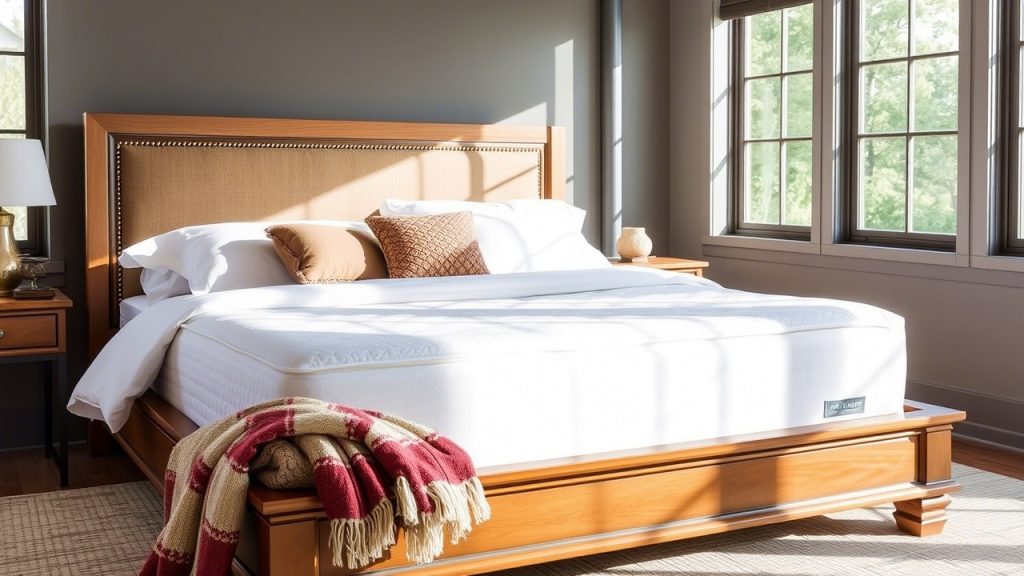How to Find the Best Bed for Back Pain Relief
Back pain is one of the most common health complaints around the world, and for many, it can be an ongoing struggle. One area where back pain can be particularly problematic is during sleep. A poor mattress or bed can exacerbate back pain, while the right mattress can help alleviate it, providing much-needed relief.
If you suffer from chronic back pain, your choice of mattress can make a world of difference. Finding the best bed for back pain relief is crucial for improving sleep quality and reducing discomfort. We’ll explore the key factors to consider when choosing a bed, how your mattress affects back pain, and tips for finding the right mattress for your specific needs.
Why the Right Bed Matters for Back Pain
Your mattress and pillow play a crucial role in maintaining spinal alignment during sleep. When your spine is in a neutral position, the muscles and ligaments have a chance to rest and heal properly. If your mattress is too firm, too soft, or worn out, it can disrupt your spine’s alignment, causing discomfort and intensifying pain.
How a Bad Mattress Affects Your Back
- Lack of Support: A mattress that doesn’t offer adequate support can cause your spine to shift out of its natural alignment, straining muscles and ligaments. Over time, this misalignment can worsen back pain.
- Pressure Points: A mattress that’s too soft can cause your body to sink in too much, creating pressure points in areas like your lower back, shoulders, or hips. This can lead to stiffness and pain, especially when you wake up.
- Inconsistent Support: A mattress that’s too firm can be just as problematic as one that’s too soft. It may not contour to the shape of your body, leading to uneven support and pressure points that aggravate back pain.
Choosing the best bed to alleviate back pain means finding one that offers proper spinal support, reduces pressure points, and suits your specific sleep style.
Key Factors to Consider for Back Pain Relief
When shopping for a bed to relieve back pain, you’ll want to focus on a few key features that ensure proper support, comfort, and alignment. Here are the most important factors to consider:
1. Mattress Firmness
The right mattress firmness is essential for back pain relief. Firmness refers to how soft or hard the mattress feels, but it’s important to understand that it’s not just about feeling comfortable—firmness affects how well your spine is supported.
- Too Soft: A mattress that’s too soft may cause your body to sink too much, which throws your spine out of alignment. This can exacerbate lower back pain.
- Too Firm: On the other hand, a mattress that’s too firm may not provide enough cushioning, especially for side sleepers. This can cause pressure on your spine and joints, worsening pain.
The best firmness level depends on your sleeping position and personal preference:
- Side Sleepers: If you sleep on your side, a medium-soft to medium-firm mattress is usually ideal, as it allows your shoulders and hips to sink in slightly while still providing spinal support.
- Back Sleepers: A medium-firm mattress is generally recommended for back sleepers, as it supports the lower back while maintaining proper spinal alignment.
- Stomach Sleepers: If you sleep on your stomach, a firmer mattress may be needed to prevent your body from sinking too deeply and arching your back unnaturally.
2. Supportive Materials
The materials used in the mattress can affect its ability to support your spine and alleviate back pain. The most common mattress materials are memory foam, innerspring coils, hybrid models, and latex. Here’s how each can help with back pain:
- Memory Foam: Memory foam mattresses are often a popular choice for people with back pain because they contour to the shape of your body, providing targeted support to your back and relieving pressure points. The material molds to your body’s curves, helping to keep your spine in alignment.
- Innerspring Coils: Traditional innerspring mattresses are equipped with metal coils for support. If they have a higher coil count and a supportive design, they can provide solid support for the back. However, they may not offer as much contouring as memory foam or hybrid mattresses.
- Hybrid Mattresses: Hybrid mattresses combine innerspring coils with layers of foam (memory foam or latex). These mattresses provide the support of coils while offering the comfort and pressure relief of foam, making them a good option for people with back pain.
- Latex: Latex mattresses are known for their durability and responsiveness. They provide solid support while offering a slightly bouncier feel compared to memory foam. Latex also tends to be cooler and more breathable, making it a good option for those who sleep hot.
3. Spinal Alignment and Pressure Relief
One of the most critical aspects of choosing a mattress for back pain relief is ensuring proper spinal alignment. The mattress should support the natural curve of your spine without forcing it into an unnatural position. A mattress that offers excellent pressure relief can help reduce pain points, especially in areas where the body exerts more pressure, such as the lower back, hips, and shoulders.
Look for a mattress that evenly distributes your body weight and prevents excessive sinking or misalignment. Many high-quality mattresses are designed with zones that provide extra support where it’s needed most, such as in the lumbar region.
4. Motion Isolation
If you share a bed with a partner who moves around a lot during the night, motion isolation can be an important consideration. Motion isolation helps minimize the amount of movement transferred across the bed, which can be especially beneficial for couples.
Memory foam and hybrid mattresses typically offer excellent motion isolation, preventing disruptions caused by a restless partner and allowing both individuals to sleep soundly without being disturbed. For those with back pain, avoiding unnecessary movement is key to reducing discomfort.
5. Sleep Position
Your preferred sleeping position greatly impacts the type of mattress you should choose for back pain relief. Here’s how to match your sleep position with the ideal mattress:
- Side Sleepers: Side sleepers often experience pressure on the shoulders and hips, which can exacerbate back pain. A mattress with a medium-soft to medium-firm feel is typically best, as it provides the necessary support while allowing these areas to sink in slightly. A memory foam or hybrid mattress can offer a good balance of comfort and support.
- Back Sleepers: Back sleepers require a mattress that supports the natural curve of the spine, particularly the lower back. A medium-firm to firm mattress is ideal, as it offers the right level of support without causing your body to sink too much. Memory foam or hybrid mattresses can be great options.
- Stomach Sleepers: Stomach sleepers need a firmer mattress to prevent the lower back from arching too much. A firm or medium-firm mattress that provides even support across the body is essential for spinal alignment. A mattress that’s too soft can cause your spine to bow, worsening back pain.
6. Durability
Back pain sufferers should look for a mattress that will remain supportive and comfortable for years to come. A mattress made from high-quality materials, such as high-density foam or durable innerspring coils, will provide long-term support.
Mattresses can lose their shape over time, so it’s important to choose one that will maintain its structure and comfort for at least 7–10 years. Look for brands that offer warranties to protect your investment.
Best Mattress Types for Back Pain Relief
1. Memory Foam Mattresses
Memory foam mattresses are widely regarded as one of the best options for back pain relief due to their ability to contour to your body’s shape. The foam provides targeted support to key areas such as the lower back, which helps alleviate pain and pressure. Memory foam also excels at motion isolation, ensuring you aren’t disturbed by your partner’s movements.
- Best for: Side sleepers, people with pressure points, individuals who need extra contouring.
2. Innerspring Mattresses
Innerspring mattresses offer a traditional feel and are often more affordable than foam-based mattresses. The coils provide excellent support, particularly for back and stomach sleepers. However, they tend to be firmer than memory foam mattresses and may not offer as much contouring or pressure relief. Hybrid versions that combine coils with foam layers may provide a better balance of support and comfort.
- Best for: Back and stomach sleepers, individuals who prefer a firmer surface.
3. Hybrid Mattresses
Hybrid mattresses combine memory foam or latex with innerspring coils to offer the best of both worlds: the support of coils and the pressure relief of foam. They are often considered ideal for people with back pain because they provide optimal spinal support while reducing pressure points.
- Best for: Combination sleepers, people who need both support and pressure relief.
4. Latex Mattresses
Latex mattresses are known for their durability, responsiveness, and support. They provide a bouncy, supportive surface that is less likely to sag over time. Latex is also naturally cooling, which makes it ideal for people who experience discomfort from overheating at night.
- Best for: Back sleepers, stomach sleepers, individuals who sleep hot.
Additional Tips for Back Pain Relief During Sleep
- Use a Supportive Pillow: A pillow that supports your neck and head is crucial for spinal alignment. Look for pillows that match your sleeping position (e.g., side sleepers benefit from thicker pillows).
- Maintain a Healthy Sleep Environment: Keep your bedroom cool, dark, and quiet to encourage restful sleep. Consider adding a mattress topper or using a heating pad or ice pack to reduce pain and stiffness before bed.
- Stretch Before Bed: Gentle stretching exercises before bed can help alleviate muscle tension in the back, making it easier to relax and sleep through the night.
Frequently Asked Questions
1. What type of mattress is best for lower back pain?
Memory foam or hybrid mattresses are often considered the best for lower back pain because they provide both support and pressure relief. Look for a medium-firm mattress that helps maintain the spine’s natural curve.
2. Can a firm mattress help with back pain?
Yes, a firm mattress can help with back pain, but it depends on your sleeping position. A medium-firm mattress is generally recommended for most people, as it provides support without being too hard.
3. Is a softer mattress better for side sleepers with back pain?
Yes, side sleepers often benefit from a softer mattress that allows their hips and shoulders to sink in slightly, relieving pressure points and ensuring proper spinal alignment.
4. How often should I replace my mattress for back pain?
You should replace your mattress every 7 to 10 years to ensure it’s still providing adequate support. If your mattress has developed lumps, sagging, or has lost its firmness, it may be time to replace it earlier.
5. Do adjustable beds help with back pain?
Yes, adjustable beds can be beneficial for back pain because they allow you to customize the angle of your bed for optimal support. Raising the head or feet can help reduce pressure on the lower back.
Conclusion
Finding the best bed for back pain relief involves considering factors like mattress firmness, support materials, spinal alignment, and your preferred sleeping position. The right mattress will provide both comfort and support, helping you wake up pain-free and well-rested. By taking your time to choose the right mattress and focusing on the features that matter most to your back health, you can enjoy better sleep and improved quality of life.





